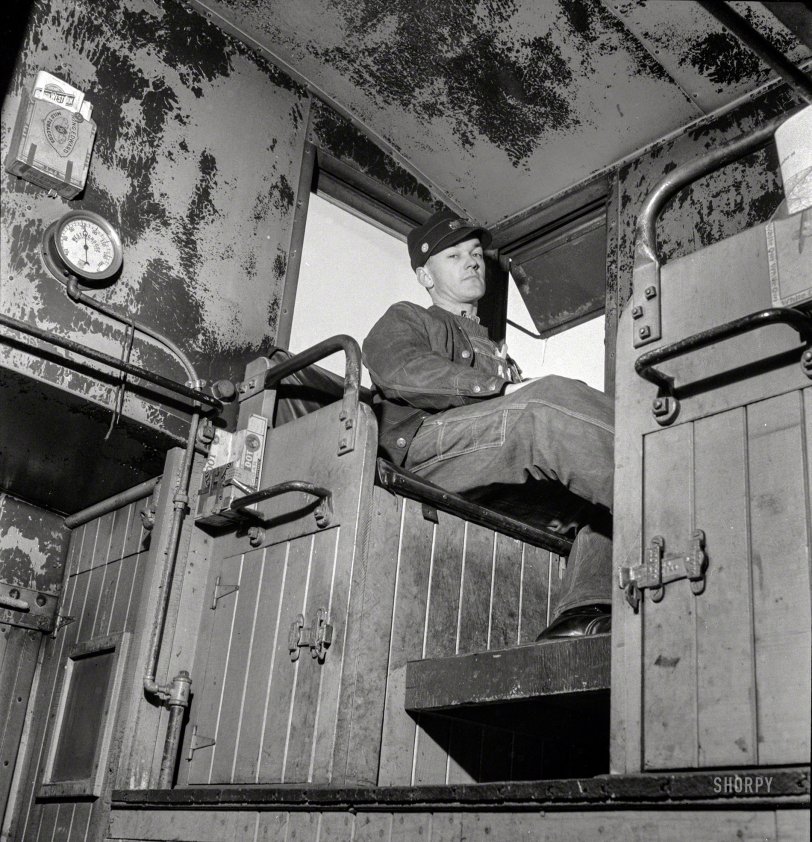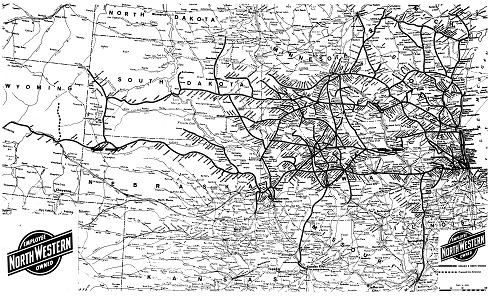


Framed or unframed, desk size to sofa size, printed by us in Arizona and Alabama since 2007. Explore now.
Shorpy is funded by you. Patreon contributors get an ad-free experience.
Learn more.

- Lost in Toyland
- And without gloves
- If I were a blindfolded time traveler
- Smoke Consumer Also Cooks
- Oh that stove!
- Possibly still there?
- What?!?
- $100 Reward
- Freeze Frame
- Texas Flyer wanted
- Just a Year Too Soon
- WWII -- Replacing men with women at the railroad crossing.
- Yes, Icing
- You kids drive me nuts!
- NOT An Easy Job
- I wonder
- Just add window boxes
- Icing Platform?
- Indiana Harbor Belt abides
- Freezing haze
- Corrections (for those who care)
- C&NW at Nelson
- Fallen Flags
- A dangerous job made worse
- Water Stop
- Passenger trains have right of way over freights?
- Coal
- Never ceases to amaze me.
- Still chuggin' (in model form)
- Great shot
Print Emporium
Rear Brakeman: 1943

March 1943. "Walter V. Dew, rear brakeman, on the Atchison, Topeka & Santa Fe between Chicago and Chillicothe, Illinois, watching the train from the cupola." Photo by Jack Delano for the Office of War Information. View full size.
What is missing.
As a kid in the 1950s I rode in several cabooses. There were girly pictures on the walls of the cabooses. None here in this pic. Perhaps removed for the portrait?
[There are plenty of girly pics in Jack Delano's other caboose shots. - Dave]
Too Gone Too Long
As a rail fan, Walter is on my list of screen saver images and each time his gaze comes round I find Randy Travis looking back at me.
Chicago and North Western Line
In the King Edward "Invincible" cigar box we may find the maps the brakerman used. The "Chicago and North Western" map we find on top, as we can see the "ball and bar" logo.
According to the Wikipedia entry on CNW, in 1943 the text must have been "Chicago & North Western Line" (1902-1944).
I suppose it was an "Employee Owned" map. here you may find one of 1977. I couldn't find one of around 1943.


Slowing down (probably)
One of Walter's jobs was to keep an eye on that gauge, which shows the air pressure in the brake line. Normally (brakes off) it'd be at something like 80 or 90 pounds. When the engineer applies the brakes, the reading would go down; here it's 74 pounds, which probably means at least a little brake application.
If the gauge dropped really low really fast, it probably meant that a brake hose was open, either because the hose burst, or because the train had broken in two. If it dropped somewhat low and stayed there, Walter knew to hang on, because the engineer was stopping hard for some reason.
Today, this monitoring function is done by a box clamped to the coupler of the last car, called a Flashing Rear End Device or FRED. The brake hose on the last car is plugged into the box, and it transmits the current pressure by radio to a display in the cab. (Some engineers call the cab display box "Mary".) As the name implies, FRED also contains the flashing red light that you see on the end of a train at night; it comes on automatically when it gets dark outside.
About that cigar box
Back when my father-in-law passed on, I was given the enjoyable task of cleaning out his basement and I found a number of old cigar boxes from HIS father. Back in the late 1930s and 1940s, these were made from a lightweight wood, unlike the heavy cardboard of today, and from what I saw in that basement, they were for a number of aftermarket uses. This photo just shows another one.
No frills
During the war the maintenance was to keep the trains running and the materials flowing. Taking a caboose or any other needed equipment out of service for cosmetic work just wasn't done
My Father
Worked for the railroad in the 1930s. He's not with us now but just recently I found out that a pitchfork of his that I use to spread mulch is actually a coal fork, he probably acquired it while working the railroad. It has R&F stamped / burned into the handle. Looking at this picture I noticed those square nuts holding parts of the cabin the brakeman is sitting in together. I have tins of these my father had in his hardware stashes and had never seen them used before. They're the same, flat on one side and sort of curved on top. He worked outdoors on the mechanicals of the train. He used to say that a lot of the guys that worked the boiler shops were gone by the 1950's, they handled a lot of asbestos I guess. He used to think this was the reason.
A quizzical smile
on his face, as if to say you're down there and I'm up here, in charge.
You never know
when half a shoelace will come in handy.
"You lookin'at me?"
Mr. Dew looks like he does not care to have his picture taken!
No maintenance
The railroad didn't spend too much on frills (paint, shelving, etc,), did it?
Old time ingenuity
Clever use of cigar boxes. Today the brakeman would complain to management and the union. After six pages of paperwork, someone would be designated to hang a couple of metal boxes.
























On Shorpy:
Today’s Top 5